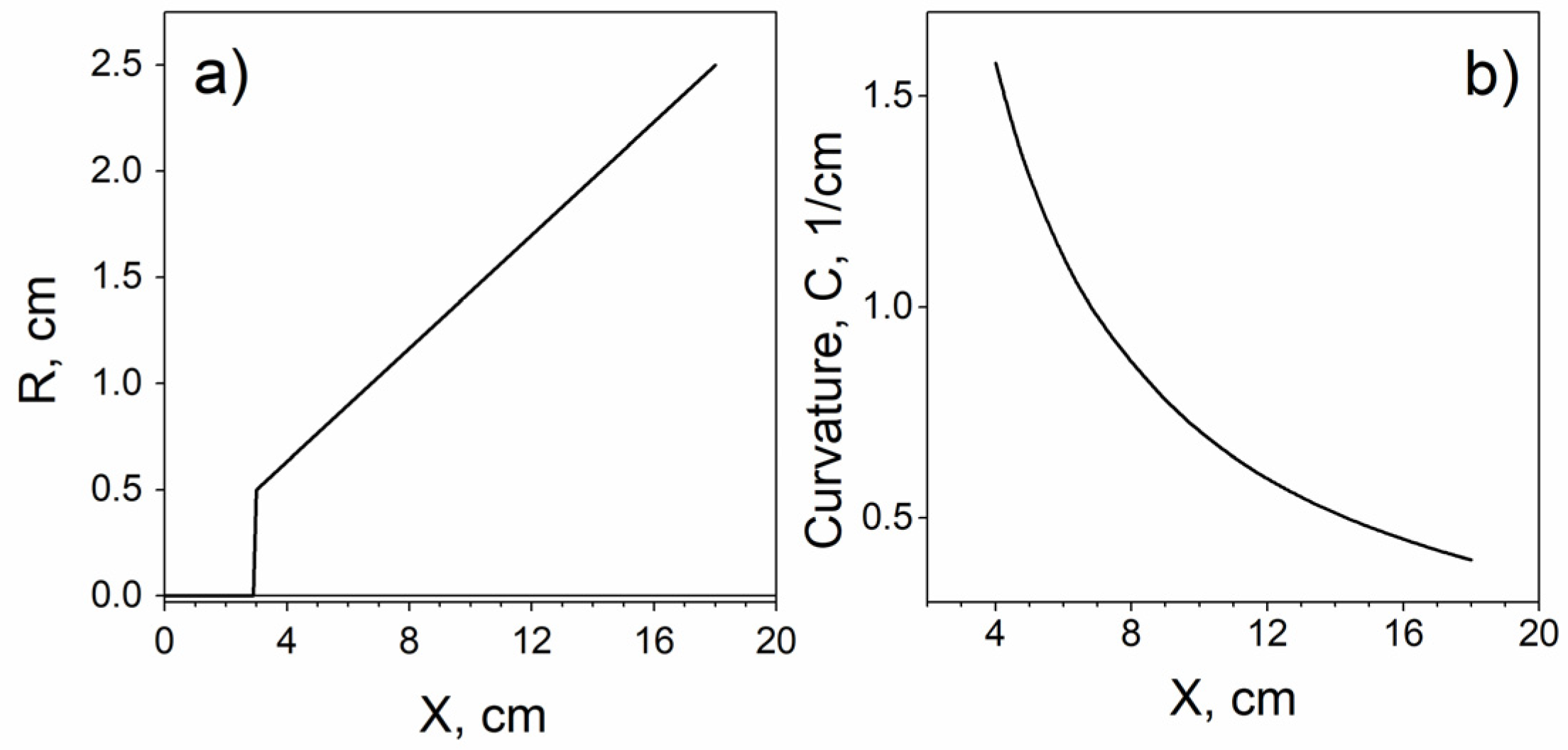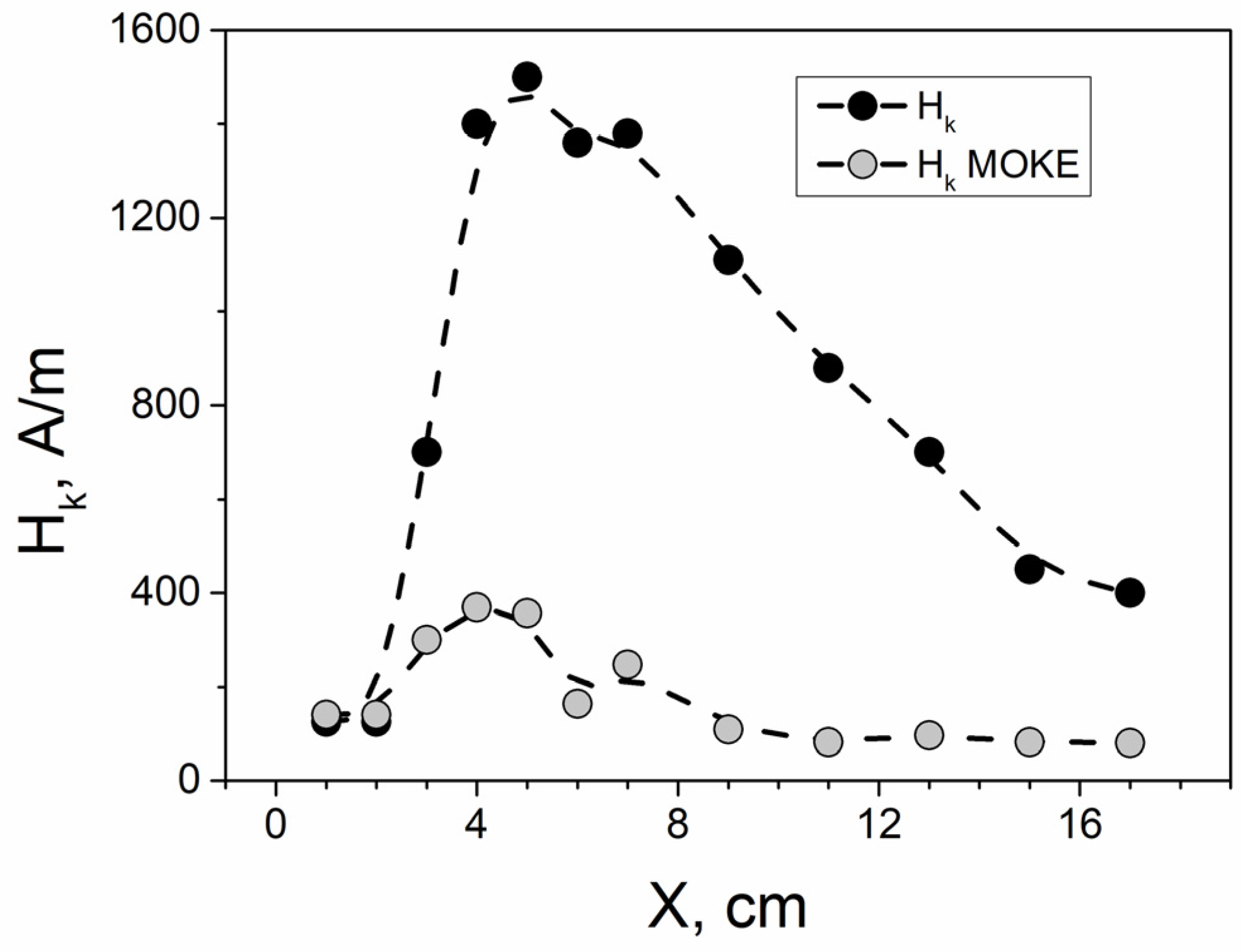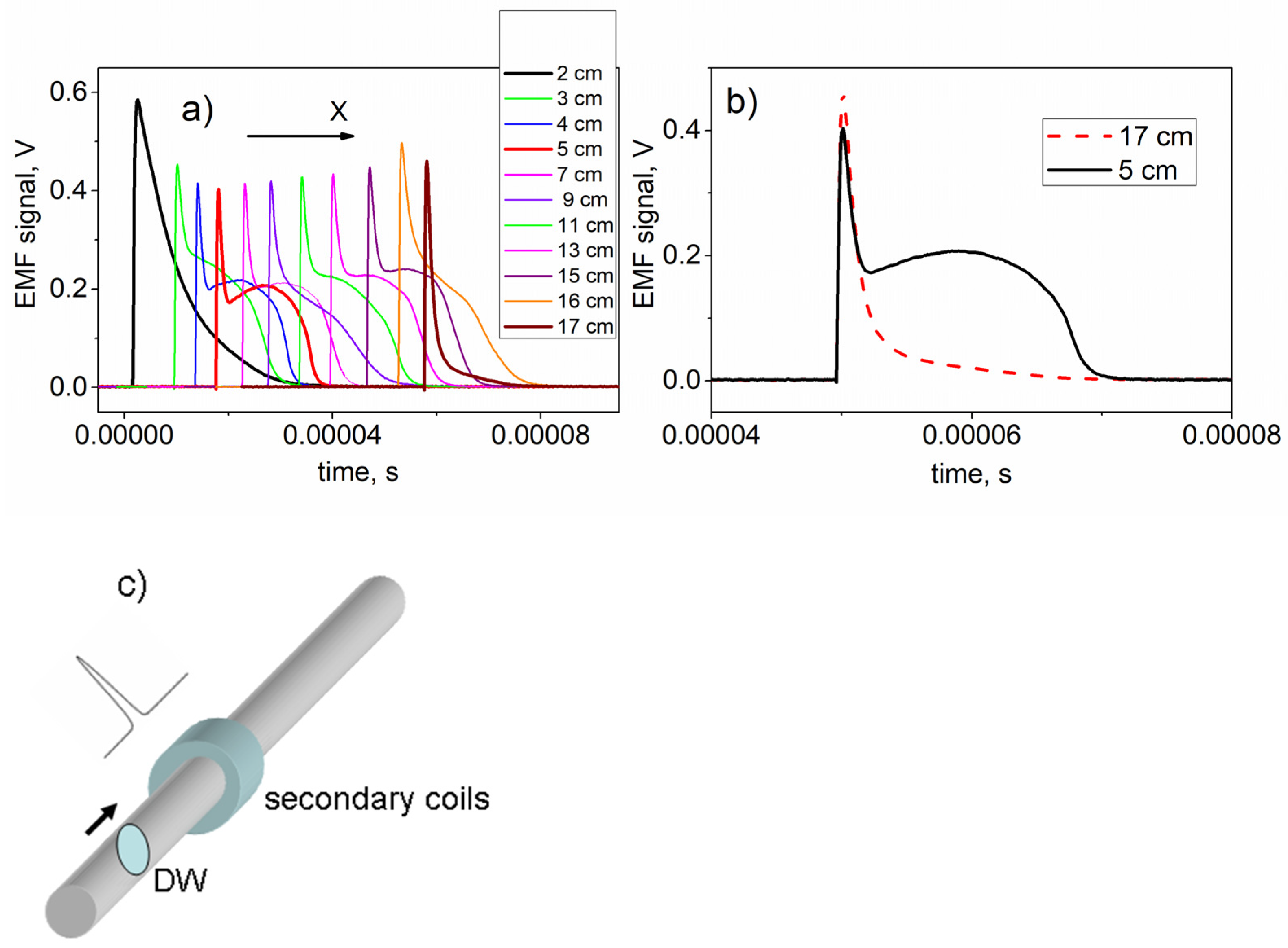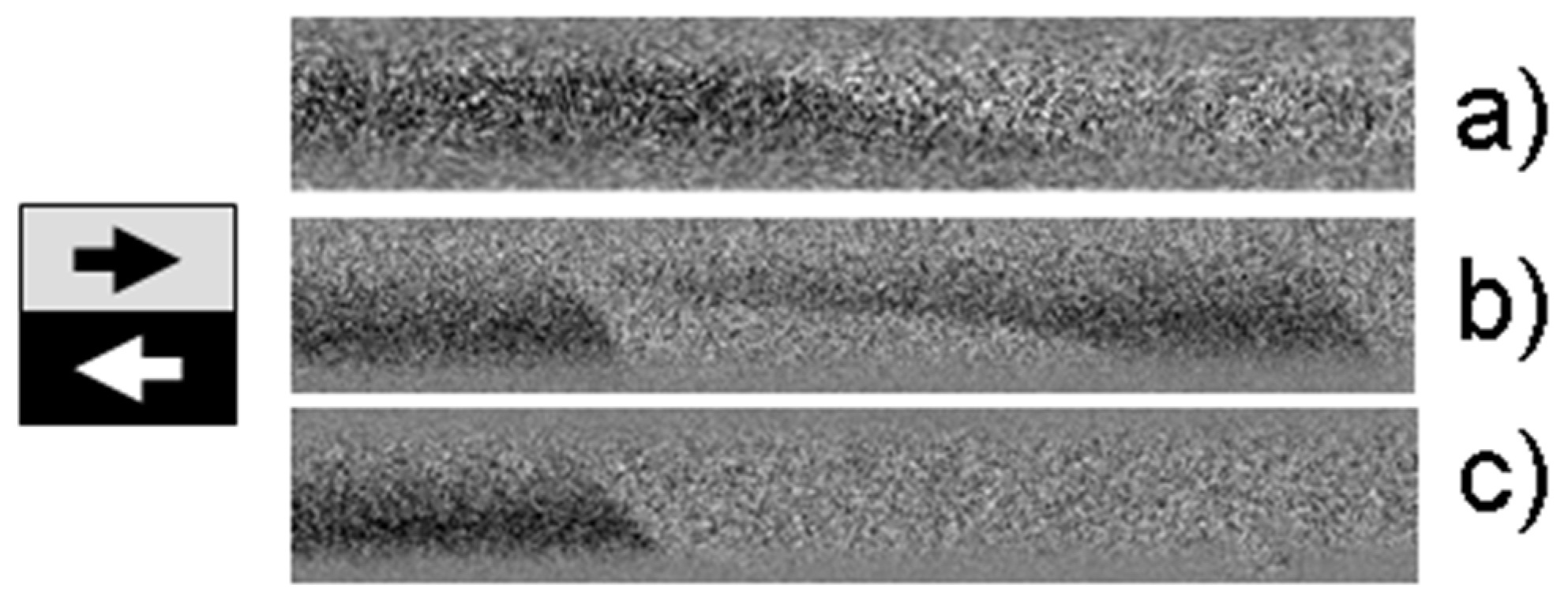Spiral Annealing of Magnetic Microwires
Abstract
:1. Introduction
2. Experimental Details
3. Results and Discussion
4. Conclusions
Author Contributions
Funding
Institutional Review Board Statement
Informed Consent Statement
Data Availability Statement
Conflicts of Interest
References
- Zhukova, V.; Corte-Leon, P.; González-Legarreta, L.; Talaat, A.; Blanco, J.M.; Ipatov, M.; Olivera, J.; Zhukov, A. Review of Domain Wall Dynamics Engineering in Magnetic Microwires. Nanomaterials 2020, 10, 2407. [Google Scholar] [CrossRef] [PubMed]
- Makhotkin, V.; Shurukhin, B.; Lopatin, V.; Marchukov, P.; Levin, Y. Magnetic field sensors based on amorphous ribbons. Sens. Actuators A Phys. 1991, 27, 759–762. [Google Scholar] [CrossRef]
- Morón, C.; Cabrera, C.; Morón, A.; García, A.; González, M. Magnetic Sensors Based on Amorphous Ferromagnetic Materials: A Review. Sensors 2015, 15, 28340–28366. [Google Scholar] [CrossRef]
- Phan, M.; Peng, H. Giant magnetoimpedance materials: Fundamentals and applications. Prog. Mater. Sci. 2008, 53, 323–420. [Google Scholar] [CrossRef]
- Nakayama, S.; Uchiyama, T. Real-time Measurement of Biomagnetic Vector Fields in Functional Syncytium Using Amorphous Metal. Sci. Rep. 2015, 5, 8837. [Google Scholar] [CrossRef]
- Sabol, R.; Klein, P.; Ryba, T.; Hvizdos, L.; Varga, R.; Rovnak, M.; Sulla, I.; Mudronova, D.; Galik, J.; Polacek, I.; et al. Novel Applications of Bistable Magnetic Microwires. Acta Phys. Pol. A 2017, 131, 1150. [Google Scholar] [CrossRef]
- Qin, F.; Peng, H.X. Ferromagnetic microwires enabled multifunctional composite materials. Prog. Mater. Sci. 2013, 58, 183–259. [Google Scholar] [CrossRef]
- Mohri, K.; Uchiyama, T.; Panina, L.V.; Yamamoto, M.; Bushida, K. Recent Advances of Amorphous Wire CMOS IC Magneto-Impedance Sensors: Innovative High-Performance Micromagnetic Sensor Chip. J. Sens. 2015, 2015, 718069. [Google Scholar] [CrossRef]
- Correa, M.A.; Ferreira, A.; Souza, A.L.R.; Dantas Neto, J.M.; Bohn, F.; Vaz, F.; Kurlyandskaya, G.V. Anomalous Nernst Effect in Flexible Co-Based Amorphous Ribbons. Sensors 2023, 23, 1420. [Google Scholar] [CrossRef]
- Andò, B.; Baglio, S.; Bulsara, A.R.; Trigona, C. Design and characterization of a microwire fluxgate magnetometer. Sens. Actuators A Phys. 2009, 151, 145–153. [Google Scholar] [CrossRef]
- Herrero-Gómez, C.; Marín, P.; Hernando, A. Bias free magnetomechanical coupling on magnetic microwires for sensing applications. Appl. Phys. Lett. 2013, 103, 142414. [Google Scholar] [CrossRef]
- Goleman, K.; Sasada, I. High Sensitive Orthogonal Fluxgate Magnetometer Using a Metglas Ribbon. IEEE Trans. Magn. 2006, 42, 3276–3278. [Google Scholar] [CrossRef]
- Edelstein, A. Advances in magnetometry. J. Phys. Condens. Matter 2007, 19, 165217. [Google Scholar] [CrossRef]
- Chiriac, H.; Lupu, N.; Stoian, G.; Ababei, G.; Corodeanu, S.; Óvári, T.-A. Ultrathin Nanocrystalline Magnetic Wires. Crystals 2017, 7, 48. [Google Scholar] [CrossRef]
- Chizhik, A.; Zhukov, A.; Gonzalez, J.; Gawroński, P.; Kułakowski, K.; Stupakiewicz, A. Spiral magnetic domain structure in cylindrically-shaped microwires. Sci. Rep. 2018, 8, 15090. [Google Scholar] [CrossRef]
- Ziman, J.; Onufer, J.; Kladivová, M. Dynamics of domain wall depinning from closure domain structure at the end of bistable glass coated microwire. J. Magn. Magn. Mater. 2020, 514, 167233. [Google Scholar] [CrossRef]
- Vazquez, M.; Chen, D.-X. The magnetization reversal process in amorphous wires. IEEE Trans. Magn. 1995, 31, 1229–1238. [Google Scholar] [CrossRef]
- Varga, R.; Torrejon, J.; Kostyk, Y.; Garcia, K.L.; Infantes, G.; Badini, G.; Vazquez, M. Single-wall dynamics and power law in bistable magnetic microwires. J. Phys. Condens. Matter. 2008, 20, 445215. [Google Scholar] [CrossRef]
- Taysioglu, A.A.; Peksoz, A.; Kaya, Y.; Derebasi, N.; Kaynak, G. GMI effect in CuO coated Co-based amorphous ribbons. J. Alloys Compd. 2009, 487, 38–41. [Google Scholar] [CrossRef]
- Malátek, M.; Kraus, L. Off-diagonal GMI sensor with stress-annealed amorphous ribbon. Sens. Actuators A Phys. 2010, 164, 41–45. [Google Scholar] [CrossRef]
- Fodil, K.; Denoual, M.; Dolabdjian, C.; Harnois, M.; Senez, V. Dynamic sensing of magnetic nanoparticles in microchannel using GMI technology. IEEE Trans. Magn. 2013, 49, 93–96. [Google Scholar] [CrossRef]
- Corodeanu, S.; Ovari, T.A.; Lupu, N.; Chiriac, H. Magnetization process and GMI effect in as-cast nanocrystalline microwires. IEEE Trans. Magn. 2010, 46, 380–382. [Google Scholar] [CrossRef]
- Zhukova, V.; Blanco, J.M.; Chizhik, A.; Ipatov, M.; Zhukov, A. AC-current-induced magnetization switching in amorphous microwires. Front. Phys. 2018, 13, 137501. [Google Scholar] [CrossRef]
- Ciureanu, P.; Melo, L.G.C.; Yelon, A. Circumferential and longitudinal 1 GHz permeabilities in Co-rich melt-extracted amorphous wires. J. Magn. Magn. Mater. 2002, 242–245, 224–228. [Google Scholar] [CrossRef]
- Rouabhi, M.; Cochrane, R.W.; Ménard, D.; Britel, M.; Ciureanu, P.; Yelon, A. Anisotropy and magnetization processes in Co-rich amorphous wires. J. Appl. Phys. 1999, 85, 5441–5443. [Google Scholar] [CrossRef]
- Zhao, Y.; Hao, H.; Zhang, Y. Preparation and giant magneto-impedance behavior of Co-based amorphous wires. Intermetallics 2013, 42, 62–67. [Google Scholar] [CrossRef]
- Mu, C.; Hu, L.; Zhu, F.; Cui, Z.; He, A.; Dong, Y.; Man, Q.; Ma, H.; Li, J. Effects of drawing and tension stress annealing on the structure and magnetic properties of Co-based amorphous wire. J. Magn. Magn. Mater. 2024, 589, 171569. [Google Scholar] [CrossRef]
- Zhukov, A.; Ipatov, M.; Corte-León, P.; Legarreta, L.G.; Churyukanova, M.; Blanco, J.; Gonzalez, J.; Taskaev, S.; Hernando, B.; Zhukova, V. Giant magnetoimpedance in rapidly quenched materials. J. Alloys Compd. 2020, 814, 152225. [Google Scholar] [CrossRef]
- Chizhik, A.; Gonzalez, G.; Zhukov, A.; Gawronski, P.; Stupakiewicz, A. Helical magnetic structures in magnetostrictive amorphous microwires. Phys. B Phys. Condens. Matter 2021, 604, 412718. [Google Scholar] [CrossRef]
- Zhou, L.; Wanga, A.; Wu, S.C.; Sun, J.; Park, S.; Jackson, T.N. All-organic active matrix flexible display. Appl. Phys. Lett. 2006, 88, 083502. [Google Scholar] [CrossRef]
- Kwon, J.H.; Kwak, W.Y.; Cho, B.K. Magnetization manipulation of a flexible magnetic sensor by controlled stress application. Sci. Rep. 2018, 8, 15765. [Google Scholar] [CrossRef] [PubMed]
- Shi, X.; Wu, M.; Lai, Z.; Li, X.; Gao, P.; Mi, W. Bending strain-tailored magnetic and electronic transport properties of reactively sputtered γ′-Fe4 N/Muscovite epitaxial heterostructures toward flexible spintronics. ACS Appl. Mater. Interfaces 2020, 12, 27394. [Google Scholar] [CrossRef]
- Cao, D.; Wang, Z.; Pan, L.; Feng, H.; Zhu, X.; Wang, J.; Liu, Q.; Han, G. Controllable magnetic and magnetostrictive properties of FeGa films electrodeposited on curvature substrates. Appl. Phys. A 2016, 122, 938. [Google Scholar] [CrossRef]
- Hen, L.; Wu, H.; Hao, C.; Hen, L.; Hang, R.; Ong, W.; Fu, S.; Tang, M. Distributed curvature sensing based on a bending loss-resistant ring-core fiber. Photonics Res. 2020, 8, 165. [Google Scholar]
- Castillo-Sepúlveda, S.; Corona, R.; Landeros, P.; Altbir, D. Domain walls in curved thin surfaces. J. Magn. Magn. Mater. 2020, 500, 166322. [Google Scholar] [CrossRef]
- Sheka, D. A perspective on curvilinear magnetism. Appl. Phys. Lett. 2021, 118, 230502. [Google Scholar] [CrossRef]
- Sheka, D.; Kravchuk, V.P.; Gaididei, Y. Curvature effects in statics and dynamics of low dimensional magnets. J. Phys. A Math. Theor. 2015, 48, 125202. [Google Scholar] [CrossRef]
- Korniienko, A.; Kravchuk, V.; Pylypovskyi, O.; Sheka, D.; Brink, J.v.D.; Gaididei, Y. Curvature induced magnonic crystal in nanowires. Sci. Post. Phys. 2019, 7, 035. [Google Scholar] [CrossRef]
- Juozapaitis, A.; Sandovic, G.; Jakubovskis, R.; Gribniak, V. Effects of Flexural Stiffness on Deformation Behaviour of Steel and FRP Stress-Ribbon Bridges. Appl. Sci. 2021, 11, 258. [Google Scholar] [CrossRef]
- Vincent, J.D.S.; Rodrigues, M.; Leong, Z.; Morley, N.A. Design and development of magnetostrictive actuators and sensors for structural health monitoring. Sensors 2020, 20, 711. [Google Scholar] [CrossRef]
- Lavvafi, H.; Lewandowski, J.R.; Lewandowski, J.J. Flex bending fatigue testing of wires, foils, and ribbons. Mater. Sci. Eng. 2014, 601, 123–130. [Google Scholar] [CrossRef]
- Panina, L.; Dzhumazoda, A.; Nematov, M.; Alam, J.; Trukhanov, A.; Yudanov, N.; Morchenko, A.; Rodionova, V.; Zhukov, A. Soft Magnetic Amorphous Microwires for Stress and Temperature Sensory Applications. Sensors 2019, 19, 5089. [Google Scholar] [CrossRef] [PubMed]
- Nematov, M.G.; Baraban, I.; Yudanov, N.A.; Rodionova, V.; Qin, F.X.; Peng, H.X.; Panina, L.V. Evolution of the magnetic anisotropy and magnetostriction in Co-based amorphous alloys microwires due to current annealing and stress-sensory applications. J. Alloys Compd. 2020, 837, 155584. [Google Scholar] [CrossRef]
- Zhukov, A.; Corte-León, P.; Blanco, J.M.; Ipatov, M.; García-Gómez, A.; Gonzalez, A.; Olivera, J.; Zhukova, V. Development of amorphous microwires with graded magnetic anisotropy. J. Magn. Magn. Mater. 2023, 587, 171358. [Google Scholar] [CrossRef]
- Korolev, D.V.; Valeev, R.A.; Piskorskii, V.P.; Koplak, O.V.; Dmitriev, O.S.; Talantsev, A.D.; Morgunov, R.B. Magnetic Anisotropy of Microwires and Domain Structure of Microstripes of PrDyCoFeB. Phys. Solid State 2021, 63, 1211. [Google Scholar] [CrossRef]
- Popov, V.V.; Buznikov, N.A. Modeling the Giant Magnetoimpedance Effect in Amorphous Microwires with Induced Magnetic Anisotropy. Phys. Met. Metallogr. 2020, 121, 1033–1038. [Google Scholar] [CrossRef]
- Delgado, A.; Oliver, J.A.; Cobos, J.A.; Rodriguez-Moreno, J. Macroscopic Modeling of Magnetic Microwires for Finite Element Simulations of Inductive Components. IEEE Trans. Power Electron. 2020, 35, 8452. [Google Scholar] [CrossRef]
- Liu, J.; Feng, Y.; Tang, R.; Zhao, R.; Gao, J.; Shi, D.; Yang, H. Mechanically Tunable Magnetic Properties of Flexible SrRuO3 Epitaxial Thin Films on Mica Substrates. Adv. Electron. Mater. 2018, 4, 1700522. [Google Scholar] [CrossRef]
- Chizhik, A.; Corte-Leon, P.; Zhukova, V.; Zhukov, V. Bend Induced Magnetic Bistability in Amorphous Microwires. Mater. Technol. 2023, 38, 2282318. [Google Scholar] [CrossRef]
- Chizhik, A.; Corte-Leon, P.; Zhukova, V.; Zhukov, V. Bending annealing induced transformation of magnetic structure in Co-rich amorphous microwires. Phys. B Condens. Matter 2024, 689, 416178. [Google Scholar] [CrossRef]
- Alimohammadi, S.; Williams, P.I.; Meydan, T. A Curvature Sensor Utilizing the Matteucci Effect in Amorphous Wire. Sensors 2023, 23, 1243. [Google Scholar] [CrossRef] [PubMed]
- Nabias, J.; Asfour, A.; Yonnet, J.P. The Impact of Bending Stress on the Performance of Giant Magneto-Impedance (GMI) Magnetic Sensors. Sensors 2017, 17, 640. [Google Scholar] [CrossRef] [PubMed]
- Zhukov, A.; Zhukova, V.; Blanco, J.M.; Gonzalez, J. Recent research on magnetic properties of glass-coated microwires. J. Magn. Magn. Mater. 2005, 294, 182. [Google Scholar] [CrossRef]
- Stupakiewicz, A.; Chizhik, A.; Tekielak, M.; Zhukov, A.; Gonzalez, J.; Maziewski, A. Direct imaging of the magnetization reversal in microwires using all-MOKE microscopy. Rev. Sci. Instrum. 2014, 85, 103702. [Google Scholar] [CrossRef]
- Gawronski, P.; Zhukova, V.; Zhukov, A.; Gonzalez, J. Manipulation of domain propagation dynamics with the magnetostaticinteraction in a pair of Fe-rich amorphous microwires. J. Appl. Phys. 2023, 114, 043903. [Google Scholar] [CrossRef]
- Zhukov, A.; Blanco, J.M.; Gonzalez, J.; Garcia Prieto, M.J.; Pina, E.; Vazquez, M. Induced magnetic anisotropy in Co–Mn–Si–B amorphous microwires. J. Appl. Phys. 2020, 87, 1402. [Google Scholar] [CrossRef]
- Buznikov, N.A.; Kurlyandskaya, G.V. Theoretical Study of Microwires with an Inhomogeneous Magnetic Structure Using Magnetoimpedance Tomography. Sensors 2024, 24, 3669. [Google Scholar] [CrossRef]
- Chizhik, A.; Corte-León, P.; Zhukova, V.; Gonzalez, J.; Zhukov, A. Longitudinal Transformation of Magnetic Properties in Magnetic Microwires With Graded Magnetic Anisotropy. IEEE Magn. Lett. 2022, 13, 7104905. [Google Scholar] [CrossRef]
- Stoney, G.G. The tension of metallic films deposited by electrolysis. Proc. R. Soc. 1909, A 82, 172–175. [Google Scholar]
- Mézin, A.; Hemel, A. Measuring coating internal stresses by the curvature method applied to a beveled sample. Surf. Coat. Technol. 2014, 258, 1128–1136. [Google Scholar] [CrossRef]
- Daunys, M.; Rimovskis, S. Analysis of circular cross-section element, loaded by static and cyclic elastic–plastic pure bending. Int. J. Fatigue 2006, 28, 211. [Google Scholar] [CrossRef]
- Jaffrès, H.; Ressier, L.; Mamy, R.; Peyrade, J.P.; Fert, A.R.; N’Guyen Van Dau, F.; Schuhl, A. Strain-induced anisotropy in thin metallic films structured by the atomic saw method. J. Magn. Magn. Mater. 1999, 196–197, 871. [Google Scholar] [CrossRef]









Disclaimer/Publisher’s Note: The statements, opinions and data contained in all publications are solely those of the individual author(s) and contributor(s) and not of MDPI and/or the editor(s). MDPI and/or the editor(s) disclaim responsibility for any injury to people or property resulting from any ideas, methods, instructions or products referred to in the content. |
© 2024 by the authors. Licensee MDPI, Basel, Switzerland. This article is an open access article distributed under the terms and conditions of the Creative Commons Attribution (CC BY) license (https://creativecommons.org/licenses/by/4.0/).
Share and Cite
Chizhik, A.; Corte-Leon, P.; Zhukova, V.; Blanco, J.M.; Gonzalez, J.; Zhukov, A. Spiral Annealing of Magnetic Microwires. Sensors 2024, 24, 6239. https://doi.org/10.3390/s24196239
Chizhik A, Corte-Leon P, Zhukova V, Blanco JM, Gonzalez J, Zhukov A. Spiral Annealing of Magnetic Microwires. Sensors. 2024; 24(19):6239. https://doi.org/10.3390/s24196239
Chicago/Turabian StyleChizhik, Alexander, Paula Corte-Leon, Valentina Zhukova, Juan Mari Blanco, Julian Gonzalez, and Arcady Zhukov. 2024. "Spiral Annealing of Magnetic Microwires" Sensors 24, no. 19: 6239. https://doi.org/10.3390/s24196239








